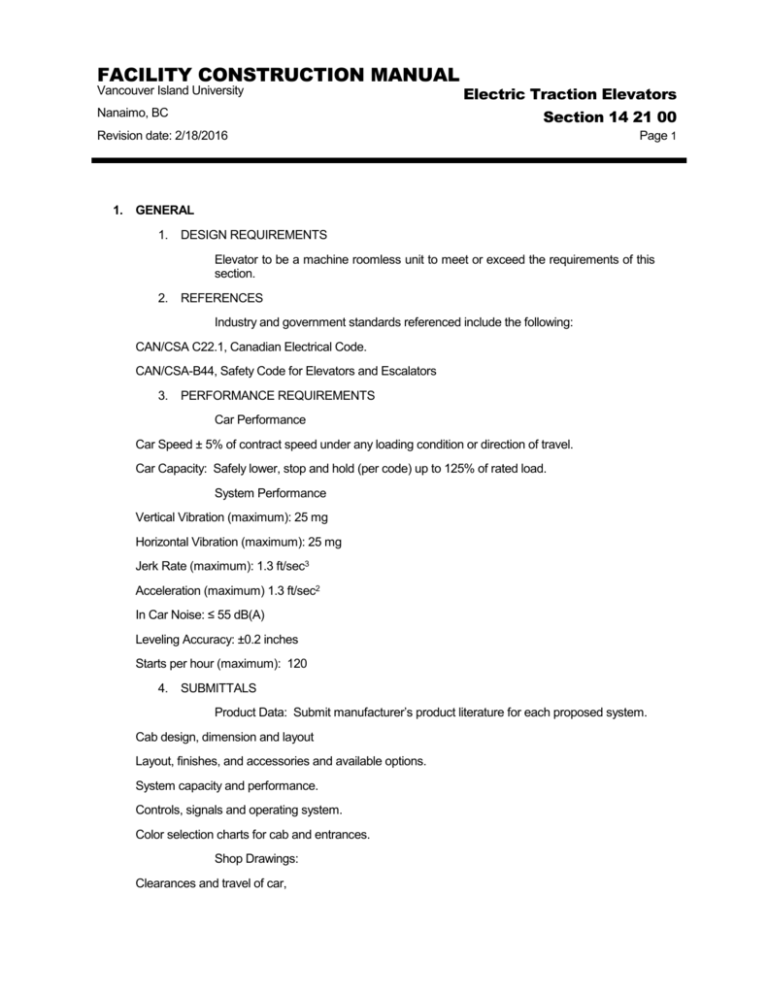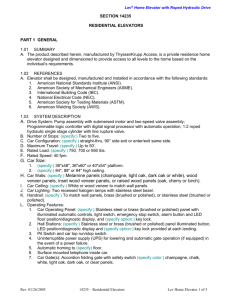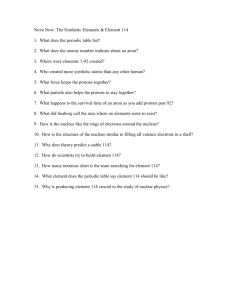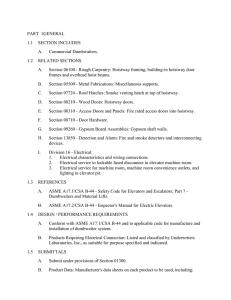Professional Memo - Vancouver Island University
advertisement

FACILITY CONSTRUCTION MANUAL
Vancouver Island University
Electric Traction Elevators
Section 14 21 00
Nanaimo, BC
Revision date: 2/18/2016
Page 1
1. GENERAL
1. DESIGN REQUIREMENTS
Elevator to be a machine roomless unit to meet or exceed the requirements of this
section.
2. REFERENCES
Industry and government standards referenced include the following:
CAN/CSA C22.1, Canadian Electrical Code.
CAN/CSA-B44, Safety Code for Elevators and Escalators
3. PERFORMANCE REQUIREMENTS
Car Performance
Car Speed ± 5% of contract speed under any loading condition or direction of travel.
Car Capacity: Safely lower, stop and hold (per code) up to 125% of rated load.
System Performance
Vertical Vibration (maximum): 25 mg
Horizontal Vibration (maximum): 25 mg
Jerk Rate (maximum): 1.3 ft/sec3
Acceleration (maximum) 1.3 ft/sec2
In Car Noise: ≤ 55 dB(A)
Leveling Accuracy: ±0.2 inches
Starts per hour (maximum): 120
4. SUBMITTALS
Product Data: Submit manufacturer’s product literature for each proposed system.
Cab design, dimension and layout
Layout, finishes, and accessories and available options.
System capacity and performance.
Controls, signals and operating system.
Color selection charts for cab and entrances.
Shop Drawings:
Clearances and travel of car,
FACILITY CONSTRUCTION MANUAL
Vancouver Island University
Electric Traction Elevators
Section 14 21 00
Nanaimo, BC
Revision date: 2/18/2016
Page 2
Clear inside hoistway and pit dimensions.
Location and layout of equipment and Signals
Car, guide rails, buffers and other components in hoistway.
Maximum rail bracket spacing.
Maximum loads imposed on building structure.
Hoist beam requirements
Location and sizes of access doors
Location and details of hoistway door and frames
Electrical characteristics and connection requirements
Closeout Submittals:
Manufacturer's operation and maintenance manuals.
Inspection Certificates and Permits.
Special Manufacturer Warranty
5. QUALITY ASSURANCE
Manufacturer: Shall have a minimum of 10 years experience in the fabrication,
installation and service of elevators. Manufacturer shall be ISO 9001 certified, and
have a documented quality assurance program.
Installer: Elevator shall be installed by the manufacturer, or a manufacturer
recommended installer with a minimum 5 years experience in the installation and
service of traction elevators.
Inspection and Testing: In accordance with requirements of local jurisdiction, obtain
required permits, inspections and tests.
Prior to beginning work of this Section, attend a pre-installation meeting. Owner,
Design Professional, and contractors with adjacent or related work shall attend.
6. DELIVERY, STORAGE AND HANDLING
Coordinate delivery of elevator material throughout construction.
Store elevator materials in protected environment in accordance with manufacturer
recommendations.
7. WARRANTY
Provide Manufacturer warranty for a period of one year. Warranty period to begin
upon Substantial Completion of the Contract. Warranty covers defects in materials
and workmanship. Damage due to ordinary use, vandalism, improper or insufficient
FACILITY CONSTRUCTION MANUAL
Vancouver Island University
Electric Traction Elevators
Section 14 21 00
Nanaimo, BC
Revision date: 2/18/2016
Page 3
maintenance, misuse, or neglect do not constitute defective material or
workmanship.
8. MAINTENANCE SERVICE
Provide maintenance service consisting of examinations and adjustments of the
elevator equipment for a period of 12 months after date of Substantial Completion.
Maintenance service shall be provided by elevator manufacturer recommended
service personnel. Manufacturer recommended parts and supplies shall be used in
maintenance service as in the original manufacture and installation.
Maintenance service be performed during regular working hours of regular working
days and shall include regular time call back service.
Maintenance service shall not include adjustments, repairs or replacement of parts
due to negligence, misuse, abuse or accidents.
2. PRODUCTS
1. MANUFACTURER
Provide machine room-less EcoSpace™ traction elevators (or approved equal) by
KONE, Inc.
AC gearless machine using embedded permanent magnets mounted to the guide rails.
Non-proprietary controls and technology.
2. MATERIALS
Steel
Sheet Steel for Exposed Work: Stretcher-leveled, cold-rolled, commercial-quality carbon steel,
complying with ASTM A366, matte finish.
Sheet Steel for Unexposed Work: Hot-rolled, commercial-quality carbon steel, pickled and oiled,
complying with ASTM A569.
Structural Steel Shapes and Plates: ASTM A36 and AISI 1018.
Stainless Steel: Type 300 Series complying with ASTM A167, with standard
tempers and hardness required for fabrication, strength and durability.
Supply with mechanical finish on fabricated work in the location shown or specified with texture and
reflectivity required (Federal and NAAMM nomenclature). Protect with adhesive plastic film or paper
covering.
All finishes specified as “satin” to be manufacturer’s standard directional polish that complies with
commercial No. 4 requirements.
Material may vary per specification.
FACILITY CONSTRUCTION MANUAL
Vancouver Island University
Electric Traction Elevators
Section 14 21 00
Nanaimo, BC
Revision date: 2/18/2016
Page 4
Bronze: Cold finished Muntz metal type UNS C28000-H02 complying with ASTM
B35/B36M.
Supply with mechanical finish on fabricated work in the location shown or specified with texture and
reflectivity required (Federal and NAAMM nomenclature). Protect with adhesive plastic film or paper
covering.
All finishes specified as "satin" to be manufacturer's standard directional polish that complies with
commercial No. 4 requirements.
All finishes specified as "mirror" to be manufacturer's standard mirror polish that complies with
commercial No. 8 requirements.
Material may vary per specification.
Aluminum: Extrusions per ASTM B221; sheet and plate per ASTM B209.
Plastic Laminate: ASTM E84 Class A and NEMA LD3, 0-1/20” (1.3 mm) up to 01/16” (1.6 mm) nominal thickness. Exposed surfaces to have color selected by
architect from manufacturer’s standard selection.
Fire-Retardant Treated Particleboard Panels: Minimum 0-1/2” (13 mm) thick backup
for plastic laminate veneered panels, provided with suitable anti-warp backing; to
meet ASTM E84 Class “A” rating with flame-spread rating of 25 or less.
Paint:
Concealed Steel and Iron: Clean metal of oil, grease, scale and other foreign matter and paint one
shop coat of manufacturer’s standard rust-resistant primer. Galvanized metal need not be painted.
Exposed Steel: Clean exposed metal of oil, grease, scale and other foreign matter. Eliminate any
dents, scratches, or other defects that would affect the final finish. For material delivered with primer
coat only, apply enamel primer. For material delivered with a finish coat, apply two coats enamel.
3. EQUIPMENT: CONTROL COMPONENTS
Controller: Provide microcomputer based control system to perform all of the
functions. The system shall also perform car and group operational control.
All high voltage (110V or above) contact points inside the controller cabinet shall be protected from
accidental contact in a situation where the controller doors are open.
Controller shall be separated into two distinct halves; Motor Drive side and Control side. High
voltage motor power conductors shall be routed and physically segregated from the rest of the
controller.
Provide a serial cardrack and main CPU board containing a non-erasable EPROM and operating
system firmware.
Variable field parameters and adjustments shall be contained in a non-volatile memory module.
Drive: Provide Variable Voltage Variable Frequency AC drive system to develop
high starting torque with low starting current.
FACILITY CONSTRUCTION MANUAL
Vancouver Island University
Electric Traction Elevators
Section 14 21 00
Nanaimo, BC
Revision date: 2/18/2016
Page 5
Controller Location: Locate controller{s} adjacent to the adjacent to the hoistway at
the top landing in an integral space.
4. EQUIPMENT: HOISTWAY COMPONENTS
Machine: AC gearless machine, with permanent magnet synchronous motor, direct
current electro-mechanical disc brakes and integral traction drive sheave, mounted
to the car guide rail at the top of the hoistway.
Governor: Friction type over-speed governor rated for the duty of the elevator
specified.
Buffers, Car and Counterweight: Polyurethane buffer.
Hoistway Operating Devices:
Emergency stop switch in the pit
Terminal stopping switches.
Emergency stop switch on the machine
Positioning System: System consisting of magnets and proximity switches.
Guide Rails and Attachments: Steel rails with brackets and fasteners. Side
counterweight arrangements to have a dual-purposed bracket that combines one
car rail with one counterweight rail on the machine side. Additional bracket supports
the other counterweight rail on the machine side and a separate bracket supports
the other car rail opposite the machine.
Ropes: Provide five hoist ropes 10-mm diameter fabricated from steel wire wound
about a steel core.
Governor Rope: Provide 3/8-inch diameter steel cable governor rope minimum eight
strands wound about a sisal core center.
Fascia: Galvanized sheet steel shall be provided at the front of the hoistway.
Hoistway Entrances
Frames: 16-gauge sheet steel, bolted construction.
Sills: extruded aluminum.
Doors: Hollow metal construction with vertical internal channel reinforcements.
Fire Rating: Entrance and doors shall be UL fire-rated for 1-1/2 hour.
Entrance Finish: baked enamel finish. Color from standard color chart.
Entrance Markings Jamb Plates: Provide standard entrance jamb tactile markings on both jambs,
at all floors. Plates shall be surface mount mounted. Plate finish to match surface mount.
5. EQUIPMENT: CAR COMPONENTS
FACILITY CONSTRUCTION MANUAL
Vancouver Island University
Electric Traction Elevators
Section 14 21 00
Nanaimo, BC
Revision date: 2/18/2016
Page 6
Car Frame: Provide car frame with adequate bracing to support the platform and car
enclosure.
Platform: Platform shall be all steel construction.
Car Guides: Provide guide-shoes mounted to top and bottom of both car and
counterweight frame. Each guide-shoe assembly shall be arranged to maintain
constant contact on the rail surfaces. Provide retainers in areas with Seismic design
requirements.
Load weighing device shall be strain gauge type mounted to dead-end hitch
attached atop the hoistway guide-rail.
Steel Cab
Panels: Non-removable vertical panels, plastic laminate selected from standard manufacturer’s
catalog of choices.
Car Front Finish: Brushed stainless steel.
Car Door Finish: Brushed stainless steel.
Ceiling: Ceiling:
Aurora [LF1 Ceiling] suspended ceiling shall consist of white translucent polycarbonate panels set
in frame of extruded natural satin finish with fluorescent lighting fixtures.
Handrail:
Round tube metal of 3/8-inch thick by 1-1/4 inch outside diameter. Material to be brushed stainless
steel. Rails to be located on sides and rear of car enclosure. Provide flat end-caps of same finish and
material as the handrail.
Flooring: By others.
Threshold: Aluminum
Emergency Car Signals
Emergency Siren: Siren mounted on top of cab that is activated when the alarm button in the car
operating panel is engaged. Siren shall have rated sound pressure level of 80 dB(A) at a distance of
three feet from device. Siren shall respond with a delay of not more than one second after activation of
alarm button.
Emergency Car Lighting: Provide emergency power unit employing a 12-volt sealed rechargeable
battery and totally static circuits shall illuminate the elevator car and provide current to the alarm bell in
the event of building power failure.
Emergency Exit Contact: An electrical contact shall be provided on the car-top exit.
Ventilation: Power ventilation.
6. EQUIPMENT: SIGNAL DEVICES AND FIXTURES
FACILITY CONSTRUCTION MANUAL
Vancouver Island University
Electric Traction Elevators
Section 14 21 00
Nanaimo, BC
Revision date: 2/18/2016
Page 7
Car Operating Panel: Provide car operating panel with all push buttons, key
switches, and message indicators for elevator operation.
Provide integral car operating panel. Panel shall contain a bank of round, mechanical, illuminated
buttons marked to correspond to landings served, emergency call button, door open button, door close
button, and key switches for lights, inspection, and exhaust fan. Buttons have amber illumination (halo)
and shall be flat flush. All buttons to have raised text and Braille marking on left hand side. The car
operating display panel shall be a 7-segment amber display. All texts, when illuminated, shall be amber.
The car operating panel shall have a brushed stainless steel finish.
Additional features of car operating panel shall include:
Car Position Indicator within operating panel (amber).
Elevator Data Plate marked with elevator capacity and car number on car top.
Illuminated alarm button with raised markings.
In car stop switch per local code.
Firefighter’s hat.
Firefighter’s Phase II Key-switch.
Call Cancel Button.
Help Button/Communicator. Activation of help button will initiate two-way communication between
car and a location inside the building, switching over to alternate location if call is unanswered, where
personnel are available to take the appropriate action. Visual indicators are provided for call initiation
and call acknowledgement.
Telephone Cabinet: Provide telephone compartment in return panel below the car operating panel.
Necessary wires for the telephone shall be included in the compartment and connected to the car
traveling cable. Telephone handset shall be furnished by others.
Landing Passing Signal: A chime bell shall sound in the car to signal that the car is either stopping
at or passing a floor served by the elevator.
Hall Fixtures: Hall fixtures shall be provided with necessary push buttons and key
switches for elevator operation. Hall fixtures shall have a brushed stainless steel
finish.
Hall fixtures shall feature round, mechanical, buttons in applied mount face frame. Hall fixtures shall
correspond to options available from that landing. Buttons shall be flat flush in vertically mounted fixture.
Hall lanterns and hall indicators shall be illuminated by means of amber illumination.
Car Lantern and Chime: A directional lantern visible from the corridor shall be
provided in the car entrance. When the car stops and the doors are opening, the
lantern shall indicate the direction in which the car is to travel and a chime will
sound. The chime will sound once for up and twice for down.
Combination Hall Position Indicator and Hall Lantern located at every floor.
FACILITY CONSTRUCTION MANUAL
Vancouver Island University
Electric Traction Elevators
Section 14 21 00
Nanaimo, BC
Revision date: 2/18/2016
Page 8
Access key-switch at top floor in entrance jamb.
7. EQUIPMENT: ELEVATOR OPERATION AND CONTROLLER
Elevator Operation
Simplex Collective Operation: Using a microprocessor-based controller, operation shall be
automatic by means of the car and hall buttons. If all calls in the system have been answered, the car
shall park at the last landing served.
Standard Operating Features to include:
Full Collective Operation
Fan and Light Control.
Load Weighing Bypass.
Ascending Car Uncontrolled Movement Protection
Top of Car Inspection Station.
Additional Operating Features to include:
Independent Service.
Zoned Access at Upper Landing.
Elevator Control System for Inspections and Emergency
Provide devices within controller to run the elevator in inspection operation.
Provide devices on car top to run the elevator in inspection operation
Provide within controller an emergency stop switch to disconnect power from the brake and
prevents motor from running.
Provide the means from the controller to mechanically lift and control the elevator brake to safely
bring car to nearest available landing when power is interrupted.
Provide the means from the controller to reset the governor over speed switch and also trip the
governor.
Provide the means from the controller to reset the emergency brake when set because of an
unintended car movement or ascending car over speed.
Provide the means for the control to reset elevator earthquake operation.
8. EQUIPMENT: DOOR OPERATOR AND CONTROL
Door Operator: A closed loop permanent magnet VVVF high-performance door
operator shall be provided to open and close the car and hoistway doors
simultaneously. Door movement shall be cushioned at both limits of travel. Electromechanical interlock shall be provided at each hoistway entrance to prevent
operation of the elevator unless all doors are closed and locked. An electric contact
FACILITY CONSTRUCTION MANUAL
Vancouver Island University
Electric Traction Elevators
Section 14 21 00
Nanaimo, BC
Revision date: 2/18/2016
Page 9
shall be provided on the car at each car entrance to prevent the operation of the
elevator unless the car door is closed.
The door operator shall be arranged so that, in case of interruption or failure of
electric power, the doors can be readily opened by hand from within the car, in
accordance with applicable code. Emergency devices and keys for opening doors
from the landing shall be provided as required by local code.
Doors shall open automatically when the car has arrived at or is leveling at the
respective landings. Doors shall close after a predetermined time interval or
immediately upon pressing of a car button. A door open button shall be provided in
the car. Momentary pressing of this button shall reopen the doors and reset the time
interval.
Door hangers and tracks shall be provided for each car and hoistway door. Tracks
shall be contoured to match the hanger sheaves. The hangers shall be designed for
power operation with provisions for vertical and lateral adjustment. Hanger sheaves
shall have polyurethane tires and pre-lubricated sealed-for-life bearings.
Electronic Door Safety Device. The elevator car shall be equipped with an
electronic protective device extending the full height of the car. When activated, this
sensor shall prevent the doors from closing or cause them to stop and reopen if they
are in the process of closing. The doors shall remain open as long as the flow of
traffic continues and shall close shortly after the last person passes through the door
opening.
3. EXECUTION
1. EXAMINATION
Field measure and examine substrates, supports, and other conditions under which
elevator work is to be performed.
Do not proceed with work until unsatisfactory conditions are corrected
2. PREPARATION
Coordinate installation of anchors, bearing plates, brackets and other related
accessories
3. INSTALLATION
Install equipment, guides, controls, car and accessories in accordance with
manufacturer installation methods and recommended practices.
Properly locate guide rails and related supports at locations in accordance with
manufacturer’s recommendations and approved shop drawings. Anchor to building
structure using isolation system to minimize transmission of vibration to structure.
All hoistway frames shall be securely fastened to fixing angles mounted in the hoistway.
Coordinate installation of sills and frames with other trades.
FACILITY CONSTRUCTION MANUAL
Vancouver Island University
Electric Traction Elevators
Section 14 21 00
Nanaimo, BC
Revision date: 2/18/2016
Lubricate operating
recommendations.
Page 10
system
components
in
accordance
with
manufacturer
Perform final adjustments, and necessary service prior to substantial completion
4. TESTING AND INSPECTIONS
Perform recommended and required testing in accordance with authority having
jurisdiction.
Obtain required permits and provide originals to Owner’s Representative.
5. DEMONSTRATION
Prior to substantial completion, instruct Owner’s Representative on the proper function
and required daily maintenance of elevators. Instruct personnel on emergency
procedures
6. SCHEDULE
Elevator Equipment: EcoSpace™ gearless traction elevator
Equipment Control: Microprocessor KCM831 control system
Rated Capacity: 2500#
Rated Speed: 150 fpm
Clear Inside Dimensions (W x D): 6’-8" x 4’-4"
Cab Height: 8’-0"
Clear height under suspended ceiling: 7’-7"
Entrance Width & Type: 3’-6"
1. Single slide left
Entrance Height: 7’-0"
Main Power Supply: 208 Volts + 5%, three-phase
Operation: Simplex Collective Operation
Machine Location: Mounted on car guide rail.
Elevator Equipment shall conform to the requirements of seismic zone for Nanaimo, BC.






